 Naruto Encore
Naruto Encore
You may have seen headlines like these: “Settlement Reached: ‘Monkey Selfie’ Case Broke New Ground for Animal Rights” (Zachary Toliver, PETA, September 11, 2017), or “Monkey Selfie Copyright Lawsuit Settled After Deal Reached” (Associated Press, September 12, 2017).
You may have read blather like Tolliver’s:
After roughly two years of court battles, the groundbreaking lawsuit asking a U.S. federal court to declare Naruto — a free-living crested macaque — the copyright owner of the internationally famous “monkey selfie” photographs has been settled. …
Naruto and the famous “monkey selfie” photographs that he undeniably took clearly demonstrate that he and his fellow macaques — like so many other animals — are highly intelligent, thinking, sophisticated beings worthy of having legal ownership of their own intellectual property and holding other rights as members of the legal community. (Emphasis added. I especially enjoy that “sophisticated.”)
Naruto’s case went all the way to a federal appeals court and shows that the struggle for animal rights is ingrained in our legal system. We’ll continue working in the courts to establish legal rights for animals. Everyone deserves the rights we hold dear: to live as they choose, to be with their families, to be free from abuse and suffering, and to benefit from their own creations.
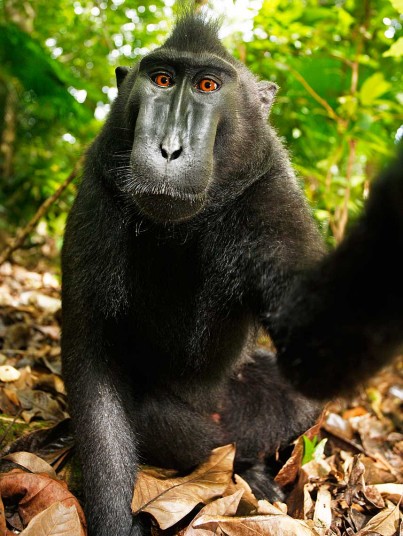
Macaque self-portrait, Indonesia, 2011.
Or even more extreme nonsense such as this, from PETA’s general counsel, Jeffrey S. Kerr, Esq.:
The story is simple. Naruto picked up the digital camera, looked into its lens, and pushed the shutter release multiple times, resulting in a series of photos. He understood the cause-and-effect relationship between pressing the shutter button, the noise of the shutter, and the change in the reflection he saw in the camera lens. (Emphasis mine.)
In these circumstances, the law recognizes that the individual who takes a photo owns its copyright regardless of age, gender, race, or, we assert, species. (“Yes, a Monkey Should Absolutely Be the Copyright Owner of His Selfie,” Alternet, July 19, 2017.)
[P]hotographs don’t exist unless someone takes them. In Naruto’s case, he intentionally picked up Slater’s camera in an Indonesian jungle, watched his reflection in the lens, and made various faces while continually pressing the shutter button. In doing so, he created several photos, including the now-famous images of his smiling face. Despite the uniqueness of the case, there was not (and should not be) anything controversial about simply asking the court to acknowledge that Naruto is the owner of the copyright to his own photographs. The Copyright Act clearly provides that any “author” of a protected work is entitled to that legal right, and PETA believes that this should include Naruto regardless of his species. (“How the Groundbreaking ‘Monkey Selfie’ Lawsuit Sets the Stage for a Major Next Step in Animal Rights,” Alternet, September 16, 2017.)
Kerr, of course, has no credible basis for his assertion that Naruto — who, so far as anyone knows, had never before handled a camera — “understood the cause-and-effect relationship between pressing the shutter button, the noise of the shutter, and the change in the reflection he saw in the camera lens,” nor even for the supposition that Naruto “watched his reflection in the lens.” Indeed, he could not prove that Naruto even understood that visual phenomenon as his own reflection.
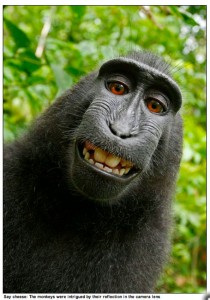
Macaque self-portrait, Indonesia, 2011, as captioned by the London Daily Mail.
Commentaries like this abound, alas. And these stories, though devoid of any actual cogent legal analysis, may have led you to conclude that a court of law has decided that Naruto has some legal claim to copyright and subsidiary licensing rights for those “selfies,” and that David Slater, the photographer whose camera Naruto handled while triggering those exposures, owns said rights but has agreed to share them with Naruto (or, more precisely, share them with human organizations working on behalf of Naruto and his fellow creatures).
Nothing could be further from the truth. Naruto’s accidental exposures do not in any way “clearly demonstrate that he and his fellow macaques — like so many other animals — are highly intelligent, thinking, sophisticated beings worthy of having legal ownership of their own intellectual property.” No court has determined that Naruto has any claim to authorship of those images, and therefore owns full or partial copyright and subsidiary licensing rights for them.
And no court has determined that David Slater owns copyright and subsidiary rights to those images. To the contrary, the legal decisions to date confirm that these images entered the public domain as soon as Naruto triggered them; they became legally available for all to use as soon as Slater authorized their publication in periodicals a few years ago. (Slater, of course, does own and control the original hi-res digital files of those images, usage of which he can license and/or refuse to license as he sees fit.) Thus I am free to reproduce those images, as I have here and in previous posts, without seeking permissions from either Slater or Naruto’s squad.
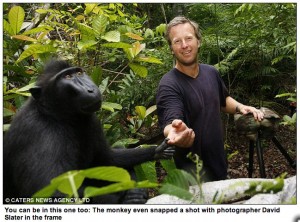
David Slater with macaque, primate photographer unidentified, Indonesia, 2011, as captioned by the London Daily Mail.
So the real story here proves far from dramatic. When Slater self-published a Blurb book including those images, People for the Ethical Treatment of Animals (PETA) sued him on behalf of Naruto. Facing the prospect of legal costs that would almost certainly outweigh his profits from these images, Slater opted to settle out of court. As the AP reports,
Under the deal, the photographer agreed to donate 25 percent of any future revenue from the images to charities dedicated to protecting crested macaques in Indonesia, said the lawyers from People for the Ethical Treatment of Animals who filed the lawsuit.
Since they settled this suit in that fashion, no significant ground got broken; certainly, no legal precedent got established. I would not anticipate a slew of copyright cases filed on behalf of squirrels and others who trigger GoPro videos; furthermore, you have my assurance that, no matter how deeply you involve them in your picture-making activities, your cats and dogs and budgies plan nothing that will require you to lawyer up.
Money Talks, Nobody Walks
Now this, from “Value of classic cars and fine art plunges as photographs soar,” by Patrick Collinson, The Guardian, September 4, 2017
Classic cars and works of fine art tumbled in value in 2016, while photography and rare musical instruments emerged as the hottest collectors’ items, according to a leading private bank. …
Photography was probably the hottest new investment area among collectables, said Coutts [a leading private bank]. A photograph of visitors to the Art Institute of Chicago in 1990 by Thomas Struth sold for $777,080 (£600,890), with pictures by Gilbert & George, Robert Mapplethorpe and Andreas Gurksy all making more than $400,000.
 “It is definitely one of our fastest growing categories,” said Brandei Estes, head of photographs at auctioneer Sotheby’s in London. “It’s the nature of the work; it is the most democratic of art forms and because of the relatively accessible price points, it’s an attractive category for the growing middle market.”
“It is definitely one of our fastest growing categories,” said Brandei Estes, head of photographs at auctioneer Sotheby’s in London. “It’s the nature of the work; it is the most democratic of art forms and because of the relatively accessible price points, it’s an attractive category for the growing middle market.”
Yes, photographs selling for upwards of USD $400K absotively and posilutely reflect the democratic nature of the medium. I couldn’t have put it better myself.
A Confusion of Doppelgängers
The 2017 Ig Nobel Prizes have been announced. And while none of them pertain directly to our field, as some have in the past, you might find this one interesting: “Is That Me or My Twin? Lack of Self-Face Recognition Advantage in Identical Twins,” by Matteo Martini, Ilaria Bufalari, Maria Antonietta Stazi, and Salvatore Maria Aglioti.
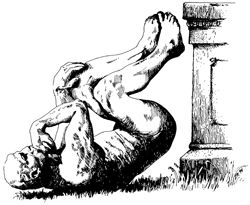
“The Stinker,” official mascot of the Ig Nobel Prizes.
I find it always rewarding to spend some time with the Ig Nobel awardees. Where else will you encounter such varied and useful material as “Didgeridoo Playing as Alternative Treatment for Obstructive Sleep Apnoea Syndrome: Randomised Controlled Trial,” “On the Rheology of Cats” (whose researcher “us[ed] fluid dynamics to probe the question ‘Can a Cat Be Both a Solid and a Liquid?'” — a question that Schrödinger somehow failed to ask), and “Why Do Old Men Have Big Ears?”
Ain’t science wonderful?
After You’ve Gone
Photographers and those who manage the archives of individual photographers might profit by pondering two recent instances of creative artists taking the initiative in deciding on the appropriate disposition of what I would call their mulch heaps: the leftovers, discards, and
Paulson writes,
Edward Albee died last fall. But the renowned playwright is making one last request from the great beyond.
Albee wants two of his friends to destroy any incomplete manuscripts he left behind.
The instruction — included in a will Albee filed on Long Island, where he lived and died — is unusual but not unprecedented. There is a term in the legal world for such instructions — dead hand control — and, although compliance has varied and enforceability is debatable, they have been attempted by artists from Franz Kafka to a Beastie Boy.
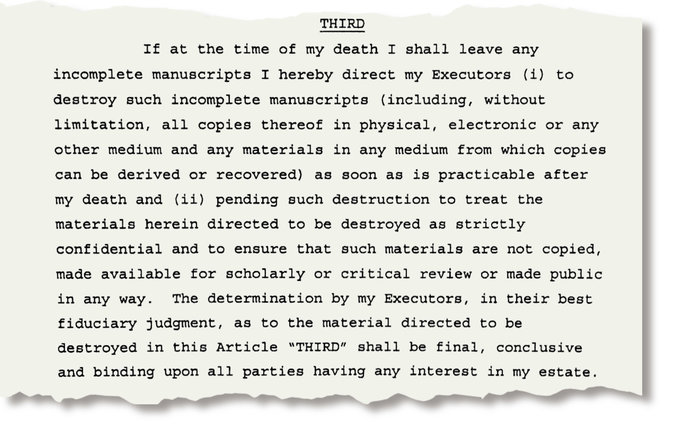
Edward Albee’s will (detail), 2012
And Rahim writes,
The late fantasy author’s hard drive, containing what is thought to be a mix of 10 unfinished and unpublished novels, has been destroyed in line with Pratchett’s wishes.
The hard drive was crushed by a six-and-a-half ton vintage steamroller named Lord Jericho at the UK’s Great Dorset Steam Fair. After being pulverized by the machine, the remains of the drive were put into a stone crusher.
Of course, you can also join the American Photography Archives Group (APAG), and line up with dozens of others hoping to place their archives with some institution.
Weighing in on Trump
This is more about demographics and graphics than photography, but the endless stream of still photos and and videos of Trump supporters over the past several years surely pertains to these analyses, and vice versa.
John Raby’s September 1, 2017 Associated Press story, “American obesity report: 1 in 3 adults are beyond overweight,” synopsizes the 14th annual State of Obesity report from the Trust for America’s Health and the Robert Wood Johnson Foundation:
• Nine of the 11 states with the highest obesity rates are in the South, and 23 of the 25 states with the highest rates of obesity are in the South and Midwest.
• Obesity rates are around 30 percent higher among adults without a college education and with incomes below $15,000 compared with other adults.
In other words: A high correlation rate exists between obesity, lack of education, and Trump voters.
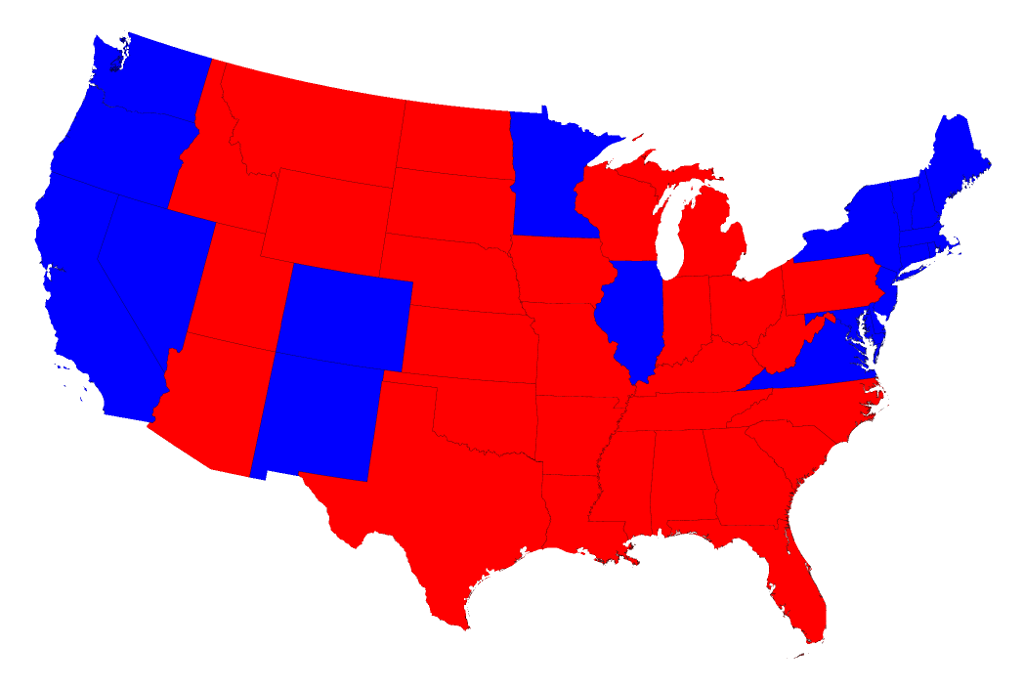
Election 2016 results. Map courtesy of Creative Commons.
Now read “How Being Fat Makes You Stupid” by Scott Rosenfield, Men’s Health, October 28, 2012 and “Does obesity affect the brain?” from Health24. Spoiler alert: The answer is yes — and not in a good way.
This helps to explain not only the decision-making processes of Trump voters, but those of Trump himself.
There’s also a high correlation between obesity and diabetes. So read the Diabetes Belt, the recent report from the Centers for Disease Control. Guess where that lies on the map? Trump country.
But diabetes also correlates with psychological problems, especially depression. See “Mental-Health Risks of Diabetes Underrecognized” by Nancy A. Melville, MedScape, July 18, 2014.
Depression has a direct connection to the relatively recent opioid, heroin, and fentanyl crises, as well as to the perennial crisis of chronic alcoholism. Like crack and meth, none of these are original to or exclusive to the red states — but those states are certainly hard hit by them.
Finally, it’s no wonder Trump “loves the uneducated.” Demographic maps show that the states with the highest percentage of their populations having 9 years or less of education cluster (surprise!) in Trump country.
This makes it safe to say that a large component of the Trump base comprises people who are overweight, cognitively impaired, emotionally disturbed, diabetic, substance-abusing, and comparatively uneducated. That’s in addition to being almost exclusively white and professedly Christian.
As Aldous Huxley wrote, “Of such is the kingdom of heaven.”
•
This post sponsored by a donation from John Teti, Sr.
•
 Special offer: If you want me to either continue pursuing a particular subject or give you a break and (for one post) write on a topic — my choice — other than the current main story, make a donation of $50 via the PayPal widget below, indicating your preference in a note accompanying your donation. I’ll credit you as that new post’s sponsor, and link to a website of your choosing. Include a note with your snail-mail address (or email it to me separately) for a free signed copy of my 1995 book Critical Focus!
Special offer: If you want me to either continue pursuing a particular subject or give you a break and (for one post) write on a topic — my choice — other than the current main story, make a donation of $50 via the PayPal widget below, indicating your preference in a note accompanying your donation. I’ll credit you as that new post’s sponsor, and link to a website of your choosing. Include a note with your snail-mail address (or email it to me separately) for a free signed copy of my 1995 book Critical Focus!
 But wait! There’s more! Donate now and I’ll include a copy of The Silent Strength of Liu Xia, the catalog of the 2012-13 touring exhibition of photos by the dissident Chinese photographer, artist, and poet, currently in her sixth year of extralegal house arrest in Beijing. The only publication of her photographic work, it includes all 26 images in the exhibition, plus another 14 from the same series, along with essays by Guy Sorman, Andrew Nathan, and Cui Weiping, professor at the Beijing Film Academy.
But wait! There’s more! Donate now and I’ll include a copy of The Silent Strength of Liu Xia, the catalog of the 2012-13 touring exhibition of photos by the dissident Chinese photographer, artist, and poet, currently in her sixth year of extralegal house arrest in Beijing. The only publication of her photographic work, it includes all 26 images in the exhibition, plus another 14 from the same series, along with essays by Guy Sorman, Andrew Nathan, and Cui Weiping, professor at the Beijing Film Academy.
Summer’s End Ends and Odds
You may have seen headlines like these: “Settlement Reached: ‘Monkey Selfie’ Case Broke New Ground for Animal Rights” (Zachary Toliver, PETA, September 11, 2017), or “Monkey Selfie Copyright Lawsuit Settled After Deal Reached” (Associated Press, September 12, 2017).
You may have read blather like Tolliver’s:
After roughly two years of court battles, the groundbreaking lawsuit asking a U.S. federal court to declare Naruto — a free-living crested macaque — the copyright owner of the internationally famous “monkey selfie” photographs has been settled. …
Naruto and the famous “monkey selfie” photographs that he undeniably took clearly demonstrate that he and his fellow macaques — like so many other animals — are highly intelligent, thinking, sophisticated beings worthy of having legal ownership of their own intellectual property and holding other rights as members of the legal community. (Emphasis added. I especially enjoy that “sophisticated.”)
Naruto’s case went all the way to a federal appeals court and shows that the struggle for animal rights is ingrained in our legal system. We’ll continue working in the courts to establish legal rights for animals. Everyone deserves the rights we hold dear: to live as they choose, to be with their families, to be free from abuse and suffering, and to benefit from their own creations.
Macaque self-portrait, Indonesia, 2011.
Or even more extreme nonsense such as this, from PETA’s general counsel, Jeffrey S. Kerr, Esq.:
The story is simple. Naruto picked up the digital camera, looked into its lens, and pushed the shutter release multiple times, resulting in a series of photos. He understood the cause-and-effect relationship between pressing the shutter button, the noise of the shutter, and the change in the reflection he saw in the camera lens. (Emphasis mine.)
In these circumstances, the law recognizes that the individual who takes a photo owns its copyright regardless of age, gender, race, or, we assert, species. (“Yes, a Monkey Should Absolutely Be the Copyright Owner of His Selfie,” Alternet, July 19, 2017.)
[P]hotographs don’t exist unless someone takes them. In Naruto’s case, he intentionally picked up Slater’s camera in an Indonesian jungle, watched his reflection in the lens, and made various faces while continually pressing the shutter button. In doing so, he created several photos, including the now-famous images of his smiling face. Despite the uniqueness of the case, there was not (and should not be) anything controversial about simply asking the court to acknowledge that Naruto is the owner of the copyright to his own photographs. The Copyright Act clearly provides that any “author” of a protected work is entitled to that legal right, and PETA believes that this should include Naruto regardless of his species. (“How the Groundbreaking ‘Monkey Selfie’ Lawsuit Sets the Stage for a Major Next Step in Animal Rights,” Alternet, September 16, 2017.)
Kerr, of course, has no credible basis for his assertion that Naruto — who, so far as anyone knows, had never before handled a camera — “understood the cause-and-effect relationship between pressing the shutter button, the noise of the shutter, and the change in the reflection he saw in the camera lens,” nor even for the supposition that Naruto “watched his reflection in the lens.” Indeed, he could not prove that Naruto even understood that visual phenomenon as his own reflection.
Macaque self-portrait, Indonesia, 2011, as captioned by the London Daily Mail.
Commentaries like this abound, alas. And these stories, though devoid of any actual cogent legal analysis, may have led you to conclude that a court of law has decided that Naruto has some legal claim to copyright and subsidiary licensing rights for those “selfies,” and that David Slater, the photographer whose camera Naruto handled while triggering those exposures, owns said rights but has agreed to share them with Naruto (or, more precisely, share them with human organizations working on behalf of Naruto and his fellow creatures).
Nothing could be further from the truth. Naruto’s accidental exposures do not in any way “clearly demonstrate that he and his fellow macaques — like so many other animals — are highly intelligent, thinking, sophisticated beings worthy of having legal ownership of their own intellectual property.” No court has determined that Naruto has any claim to authorship of those images, and therefore owns full or partial copyright and subsidiary licensing rights for them.
And no court has determined that David Slater owns copyright and subsidiary rights to those images. To the contrary, the legal decisions to date confirm that these images entered the public domain as soon as Naruto triggered them; they became legally available for all to use as soon as Slater authorized their publication in periodicals a few years ago. (Slater, of course, does own and control the original hi-res digital files of those images, usage of which he can license and/or refuse to license as he sees fit.) Thus I am free to reproduce those images, as I have here and in previous posts, without seeking permissions from either Slater or Naruto’s squad.
David Slater with macaque, primate photographer unidentified, Indonesia, 2011, as captioned by the London Daily Mail.
So the real story here proves far from dramatic. When Slater self-published a Blurb book including those images, People for the Ethical Treatment of Animals (PETA) sued him on behalf of Naruto. Facing the prospect of legal costs that would almost certainly outweigh his profits from these images, Slater opted to settle out of court. As the AP reports,
Under the deal, the photographer agreed to donate 25 percent of any future revenue from the images to charities dedicated to protecting crested macaques in Indonesia, said the lawyers from People for the Ethical Treatment of Animals who filed the lawsuit.
Since they settled this suit in that fashion, no significant ground got broken; certainly, no legal precedent got established. I would not anticipate a slew of copyright cases filed on behalf of squirrels and others who trigger GoPro videos; furthermore, you have my assurance that, no matter how deeply you involve them in your picture-making activities, your cats and dogs and budgies plan nothing that will require you to lawyer up.
Money Talks, Nobody Walks
Now this, from “Value of classic cars and fine art plunges as photographs soar,” by Patrick Collinson, The Guardian, September 4, 2017
Classic cars and works of fine art tumbled in value in 2016, while photography and rare musical instruments emerged as the hottest collectors’ items, according to a leading private bank. …
Photography was probably the hottest new investment area among collectables, said Coutts [a leading private bank]. A photograph of visitors to the Art Institute of Chicago in 1990 by Thomas Struth sold for $777,080 (£600,890), with pictures by Gilbert & George, Robert Mapplethorpe and Andreas Gurksy all making more than $400,000.
Yes, photographs selling for upwards of USD $400K absotively and posilutely reflect the democratic nature of the medium. I couldn’t have put it better myself.
A Confusion of Doppelgängers
The 2017 Ig Nobel Prizes have been announced. And while none of them pertain directly to our field, as some have in the past, you might find this one interesting: “Is That Me or My Twin? Lack of Self-Face Recognition Advantage in Identical Twins,” by Matteo Martini, Ilaria Bufalari, Maria Antonietta Stazi, and Salvatore Maria Aglioti.
“The Stinker,” official mascot of the Ig Nobel Prizes.
I find it always rewarding to spend some time with the Ig Nobel awardees. Where else will you encounter such varied and useful material as “Didgeridoo Playing as Alternative Treatment for Obstructive Sleep Apnoea Syndrome: Randomised Controlled Trial,” “On the Rheology of Cats” (whose researcher “us[ed] fluid dynamics to probe the question ‘Can a Cat Be Both a Solid and a Liquid?'” — a question that Schrödinger somehow failed to ask), and “Why Do Old Men Have Big Ears?”
Ain’t science wonderful?
After You’ve Gone
Photographers and those who manage the archives of individual photographers might profit by pondering two recent instances of creative artists taking the initiative in deciding on the appropriate disposition of what I would call their mulch heaps: the leftovers, discards, and
Paulson writes,
Edward Albee died last fall. But the renowned playwright is making one last request from the great beyond.
Albee wants two of his friends to destroy any incomplete manuscripts he left behind.
The instruction — included in a will Albee filed on Long Island, where he lived and died — is unusual but not unprecedented. There is a term in the legal world for such instructions — dead hand control — and, although compliance has varied and enforceability is debatable, they have been attempted by artists from Franz Kafka to a Beastie Boy.
Edward Albee’s will (detail), 2012
And Rahim writes,
The late fantasy author’s hard drive, containing what is thought to be a mix of 10 unfinished and unpublished novels, has been destroyed in line with Pratchett’s wishes.
The hard drive was crushed by a six-and-a-half ton vintage steamroller named Lord Jericho at the UK’s Great Dorset Steam Fair. After being pulverized by the machine, the remains of the drive were put into a stone crusher.
Of course, you can also join the American Photography Archives Group (APAG), and line up with dozens of others hoping to place their archives with some institution.
Weighing in on Trump
This is more about demographics and graphics than photography, but the endless stream of still photos and and videos of Trump supporters over the past several years surely pertains to these analyses, and vice versa.
John Raby’s September 1, 2017 Associated Press story, “American obesity report: 1 in 3 adults are beyond overweight,” synopsizes the 14th annual State of Obesity report from the Trust for America’s Health and the Robert Wood Johnson Foundation:
• Nine of the 11 states with the highest obesity rates are in the South, and 23 of the 25 states with the highest rates of obesity are in the South and Midwest.
• Obesity rates are around 30 percent higher among adults without a college education and with incomes below $15,000 compared with other adults.
In other words: A high correlation rate exists between obesity, lack of education, and Trump voters.
Election 2016 results. Map courtesy of Creative Commons.
Now read “How Being Fat Makes You Stupid” by Scott Rosenfield, Men’s Health, October 28, 2012 and “Does obesity affect the brain?” from Health24. Spoiler alert: The answer is yes — and not in a good way.
This helps to explain not only the decision-making processes of Trump voters, but those of Trump himself.
There’s also a high correlation between obesity and diabetes. So read the Diabetes Belt, the recent report from the Centers for Disease Control. Guess where that lies on the map? Trump country.
But diabetes also correlates with psychological problems, especially depression. See “Mental-Health Risks of Diabetes Underrecognized” by Nancy A. Melville, MedScape, July 18, 2014.
Depression has a direct connection to the relatively recent opioid, heroin, and fentanyl crises, as well as to the perennial crisis of chronic alcoholism. Like crack and meth, none of these are original to or exclusive to the red states — but those states are certainly hard hit by them.
Finally, it’s no wonder Trump “loves the uneducated.” Demographic maps show that the states with the highest percentage of their populations having 9 years or less of education cluster (surprise!) in Trump country.
This makes it safe to say that a large component of the Trump base comprises people who are overweight, cognitively impaired, emotionally disturbed, diabetic, substance-abusing, and comparatively uneducated. That’s in addition to being almost exclusively white and professedly Christian.
As Aldous Huxley wrote, “Of such is the kingdom of heaven.”
•
This post sponsored by a donation from John Teti, Sr.
•